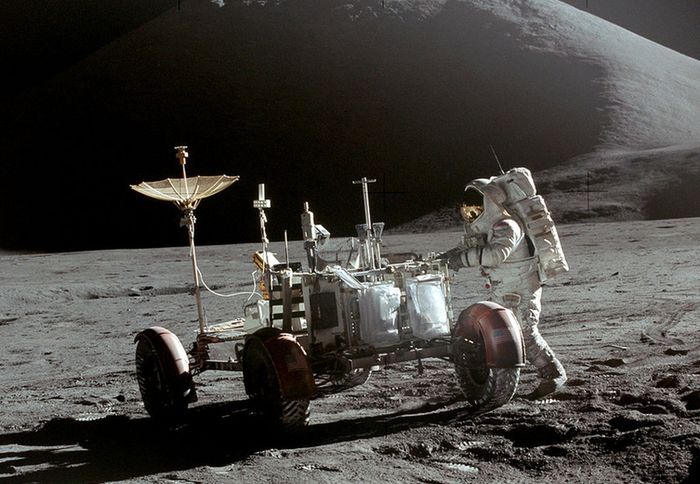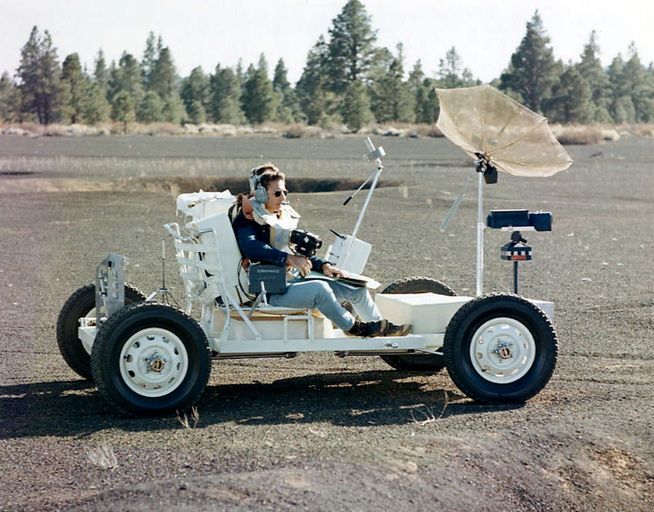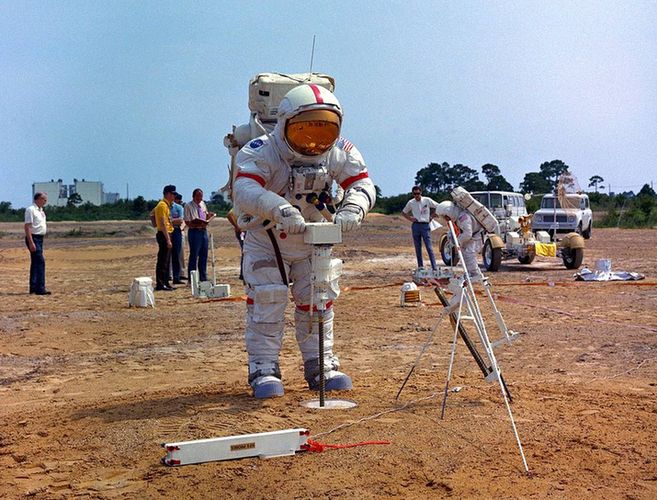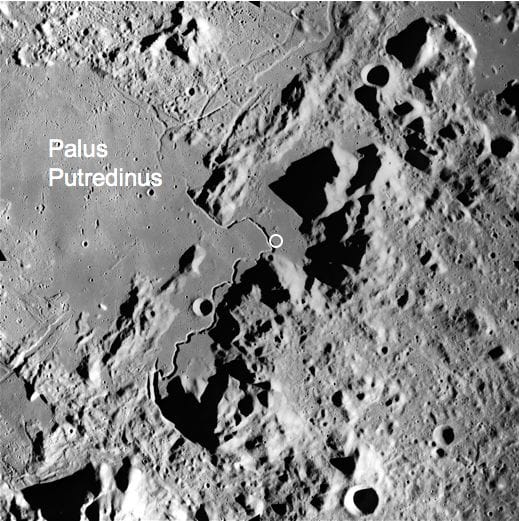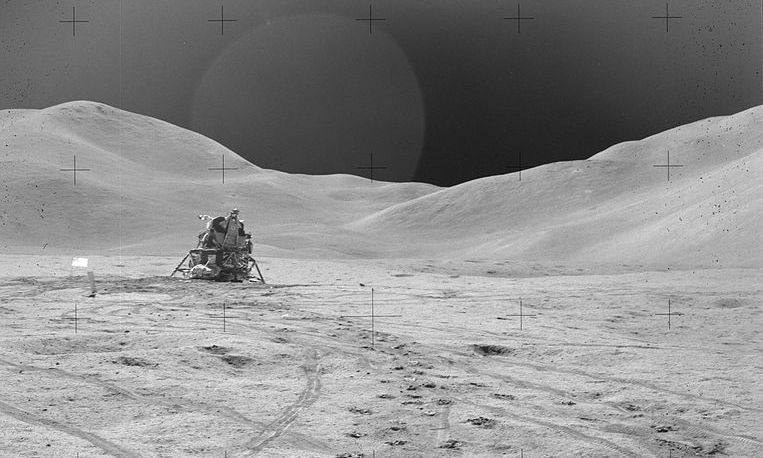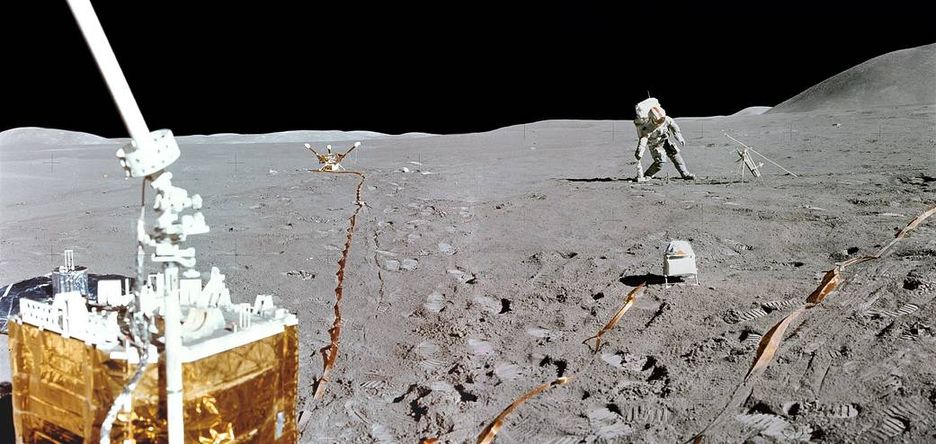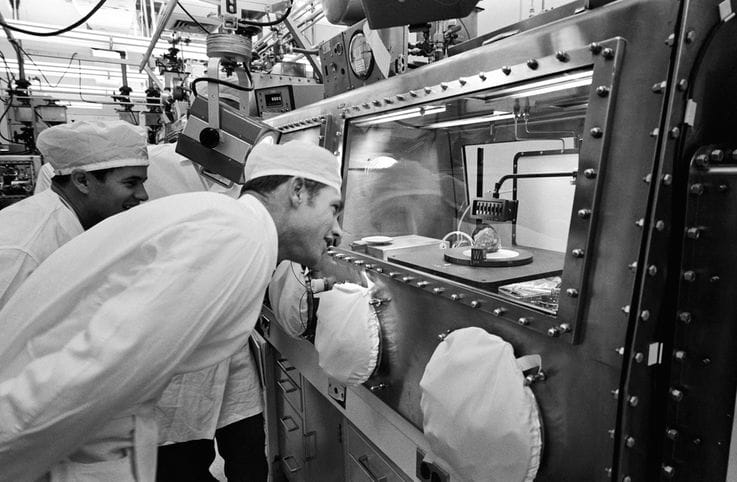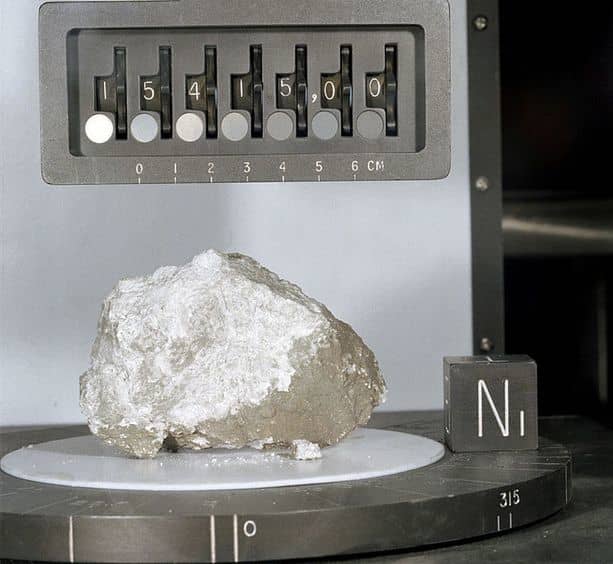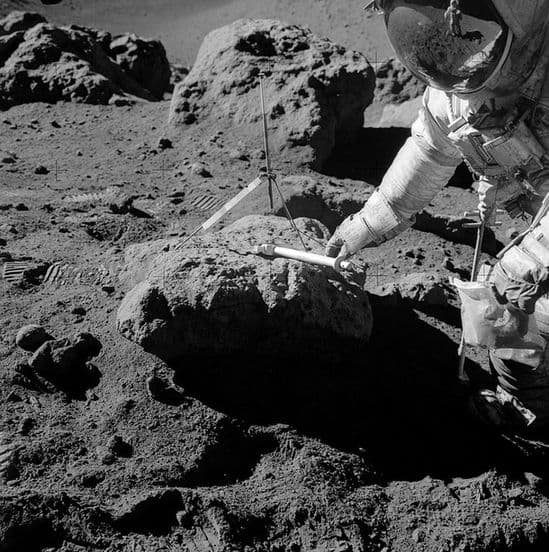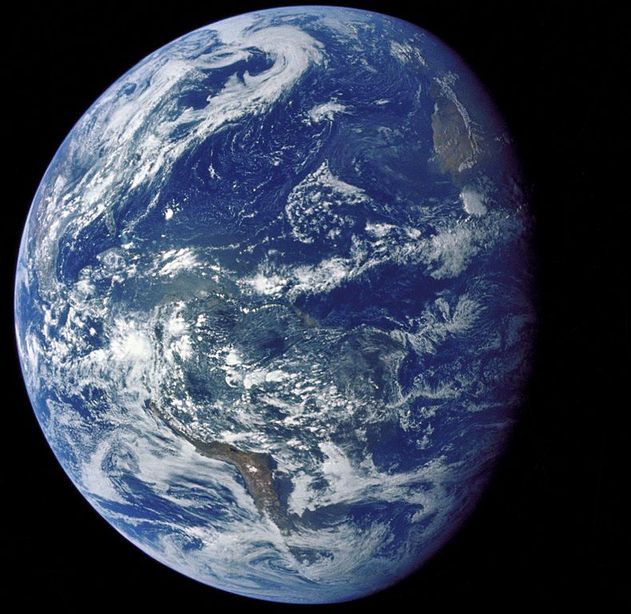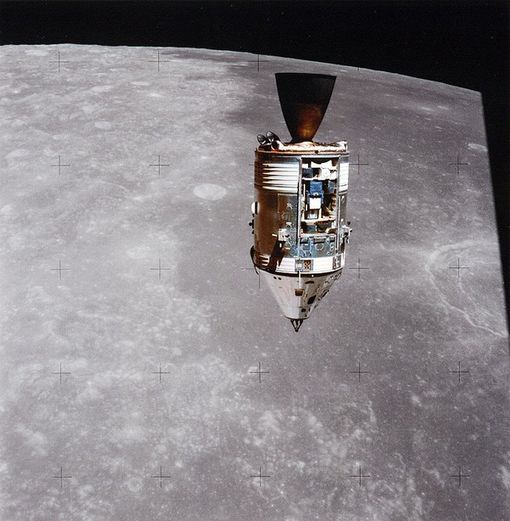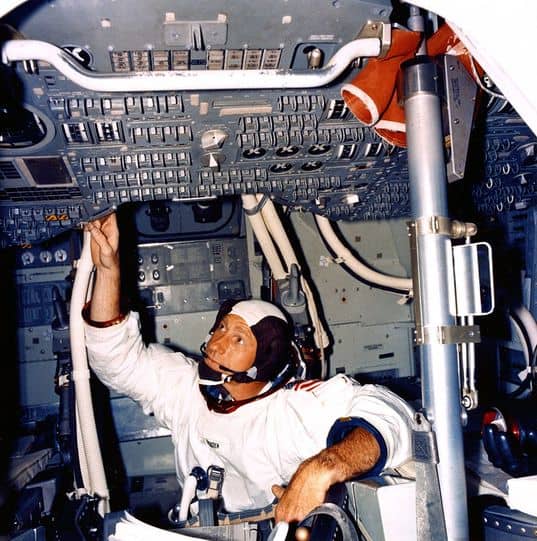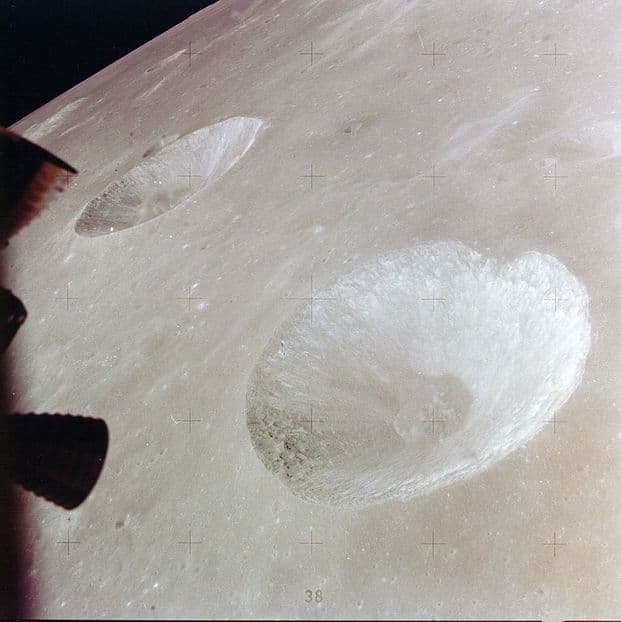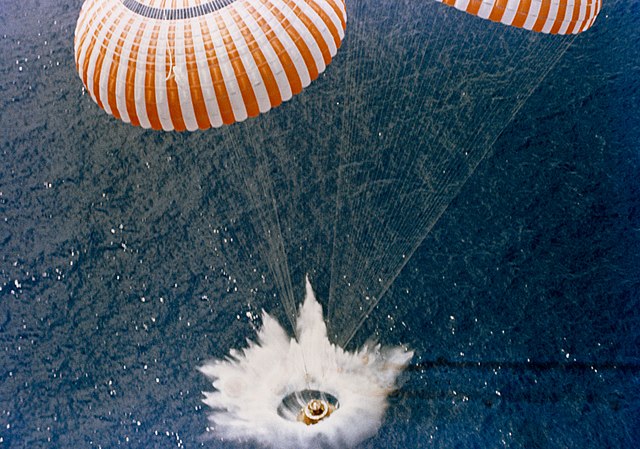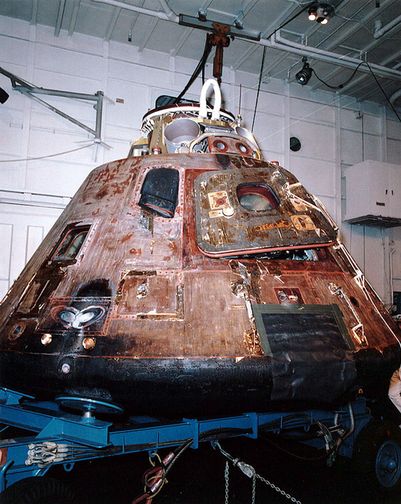The Apollo 15 was the fourth U.S. spacecraft to land on the Moon. And although the mission achieved its goals, it is also remembered for its hiccups and controversies.
Let’s review the good and the bad.
The Apollo 15 mission

The U.S. had already launched 24 spacecraft into space, and 3 of them had landed on the Moon’s surface. So this time, NASA turned things up a notch.
Apollo 15 stayed longer on the Moon’s surface. And it also had a stronger scientific component than the previous missions.
The Apollo launched on July 26, 1971, with three astronauts on board.
They had four goals to accomplish. The first one was to explore the landing area of the Moon. It is called Hadley-Apennine and is a mountainous region full of craters and canyons.
Then, the astronauts were to set up scientific experiments on the Moon’s surface to learn more about both the Moon and the Earth.
The third objective was an easy one. NASA redesigned the astronauts’ equipment, and the trio was to evaluate the changes.
And the final one was to orbit the Moon conducting more experiments and taking pictures.
The astronauts achieved all the mission’s objectives. They returned safely to Earth 12 days after they left: on August 7, 1971.
The Apollo 15 shuttle

At first sight, the shuttle looks like one big rocket. Yet, it is actually made up of several parts that get discarded during the journey. And only one small part, the tip, returns to Earth.
The first thing to go is the rocket itself, which is the largest part of the shuttle. It is only needed to launch from Earth. Once in space, it is ejected.
Now two main parts remain: the Command/Service Module and the Lunar Module.
They are attached when they travel to the Moon. But once there, the Command Module, called Endeavor, stays orbiting the Moon. Meanwhile, the Lunar Module Falcon, manned by two astronauts, detaches and makes its way to the lunar surface.
After three days on the surface, the Falcon lifts off and rejoins the orbiting Endeavor.
Once the three astronauts are back on the Endeavor, they discard the Lunar Module, which crashes against the Moon’s surface.
But they still have one more part to get rid of. When they are about to reenter Earth, the Endeavor splits in two, ejecting the Service Module. Only the Command Module, which is the tip of the original shuttle, reenters Earth’s atmosphere.
Read next: These Elon Musk Companies Are Propelling You Into the Future
The players

Like in all the previous space missions, the three crew members had been Air Force pilots.
Lieut. Col. Al Worden orbited the Moon in the Endeavor. And Colonels Dave Scott and Jim Irwin are the astronauts who landed on the Moon and explored it.
David Scott
Dave was the commander of the Apollo 15 mission, aka the boss.
The Texan was born in 1932 in the military airbase where his father was serving. Since he was a boy, he wanted to be a pilot, just like his dad.
His swimming prowess won him a scholarship from the University of Michigan. He studied Engineering. West Point, the prestigious military school, took notice of the young engineer with top grades. They invited him to attend, which fulfilled one of Dave’s dreams.
Then, Dave became a test pilot for the U.S. Air Force. He even did a stint as a fighter pilot in Europe during the Cold War.
After a while, the 31-year-old hotshot applied to NASA’s space program -he had a master’s in Aeronautics from MIT. He was accepted.
Before being chosen as Apollo 15’s commander, Dave went to space twice. The first time with Neil Armstrong in the Gemini 8 (1966), and the second as the pilot of Apollo 9‘s Command Module (1969).
The Apollo 15 mission was his third time in space.
James Irwin
Jim dreamt of being the first person to walk on the Moon. Problem was, this was in 1942, and no one had done it yet. So when the 12-year-old shared his vision with his neighbors, they laughed at him. While his practical mom said he could not live on the Moon.
But Jim was not deterred.
In 1951, he got his bachelor’s degree in Naval Science from the US Naval Academy. He followed it with degrees in Aeronautical and Instrumentation Engineering.
Then, the Pittsburgh-native became an F-12 pilot and a test pilot for the Air Force. He received several medals.
And in 1966, NASA recruited him.
Three years later, he was in the support crew for Apollo 10 and in the backup crew for Apollo 12, along with Dave Scott.
In 1971, Jim was the Lunar Module Pilot for the Apollo 15. The 41-year-old may not have been the first man to take a walk on the Moon, as he had dreamt, but he was the 8th.
Alfred Worden
Unlike his fellow crew members, Al fell into his career by chance.
All he knew when he was a child was that he did not want to keep working on his family’s farm in Michigan. With the help of his high-school principal, Al landed a free spot at coveted West Point.
He followed the normal military career path, ended up being a pilot, and eventually applied to the space program.
Al was part of the support crew of Apollo 9. And later on, along with both Dave and Jim, on the backup team for Apollo 12.
In 1971, the 39-year-old went to space for the first time as the Command Module’s pilot for Apollo 15. He is the one that orbited the Moon while his comrades landed on the Moon’s surface.
Geology training for the Apollo crew

During the first space missions, NASA was just trying to get to space and the Moon. While scoring some points against its arch-enemy the USSR, that is.
But with Apollo 15, the objectives expanded. NASA realized they had an opportunity to do scientific experiments and to learn about the Moon’s history.
So during the 20 months that the pilots trained for their mission, they also attended hundreds of hours of geology classes.
Their teachers were Cal Tech’s geologist Leon Silver and NASA’s geologist Farouk El-Baz. They taught the pilots how to describe a landscape and to recognize different types of rocks.
The teachers also took them on field trips once a month. So they studied geology on the terrain of Hawaii, California’s desert, New Mexico, and NASA’s own backyard, the Kennedy Center in Florida.
By the end of the program, commander Dave Scott had taken quite a liking to it. He proudly considered himself an amateur geologist.
The intense NASA training took its toll on two marriages, though. The Irwins made it through, but the Wordens divorced before the mission.
New gadgets for the Apollo 15
For the Apollo 15 mission, NASA redesigned the spacesuits and the ‘backpacks.’ They also built a lunar vehicle.
The Moon suits: The zipper was changed. It now went diagonally from hip to shoulder. That increased the range of motion of the legs and diminished both abrasion and shoulder pressure. The designers also changed the waist of the suits so the astronauts could bend completely and sit on the lunar vehicle.
The ‘backpacks’: the equipment the pilots carried on their backs were also redesigned. They now allowed for longer walks on the Moon. They now carried more oxygen, more water, and had longer battery life.
The suit and equipment weighed 500 lbs (227 kg) on Earth and 80 lbs (36 kg) on the Moon. During the training on Earth, the astronauts did wear the whole 500 lbs ensemble.
The rover: for this mission, NASA wanted a car that could roam the Moon’s surface. Boeing built three Lunar Roving Vehicles (LRV) for 40 million dollars -which was quite the price tag 50 years ago.
The rover weighed 460 lbs (209 kg) on Earth and could be folded. The terrain it was going to survey was rocky, so it had to be a 4-wheel drive. It looked a bit like the cars that are used to drive on desert dunes, and it could go at 7.5 mph (12 kph).
This was the first mission in which a rover was used. It allowed the astronauts to cover a lot more terrain. Previously, the astronauts had only walked on the Moon and covered about 2 mi (3.5 km) in each mission. In contrast, the Apollo 15 team covered 17.5 mi (28 km).
The rover did not return to Earth, the crew left it on the Moon.
Apollo 15 lands on the Moon
On the 26 of July of 1971, the shuttle launched from the Kennedy Space Center at Merrit Island, Florida.
Four days later, Apollo 15 was orbiting the Moon.
Then the Lunar Module (Falcon) detached from the Endeavor to make its way to the Moon’s surface.
Back on Earth, the astronauts had practiced the landing a thousand times. They had gone through every detail. Even the landing hour had been scheduled so they would have the right light when approaching the site. But now their spacecraft’s exhaust was disturbing the Moon’s dust. Between that and the mountain’s shadows, Scott and Irwin could not see the Moon’s surface clearly.
The result was a rough landing. Irwin has said that it was the roughest landing he had ever been in. And for a while, the two astronauts feared that their tilted vehicle would tip over.
They did not even land in the exact site they were supposed to, but 910 m (3,000 ft) away. Although it still was in the mountainous Hadley-Apennine region.
The Apollo 15’s moonwalks (EVAS)

Once they got everything under control, Commander Scott suited up. And he opened the hatch to take a good look at the Moon’s surface, as any good geologist would do.
From the hatch, he surveyed the terrain, took panoramic pictures, and described the landscape to Mission Control. That took 33 minutes.
On the second day, July 31, both Scott and Irwin left the Falcon to explore the surface of the Moon and collected soil samples. But when Scott tried to drill the ground to set up an experiment, he was unsuccessful. The soil turned out to be a lot tougher than anyone had anticipated. Tired, he finally left the drill in its place, and the astronauts returned to their ship. That first Extra-vehicular Activity (EVA), or spacewalk, lasted 6 hrs and 32 min.
The third day, they went out again, explored more craters and mountains, and Scott finished drilling. They returned to the Falcon after a 7 hrs and 12 min EVA.
On their last day, they spent most of their 4-hour EVA struggling again with the drill, trying to break away a part of the Moon’s core. It took so long that they had to skip the other planned explorations. They did have time to pin the U.S. flag and take some pictures with it, though.
The 4 combined EVAS lasted 19 hours, that is 10 more hours than the spacewalks of the previous Apollo mission.
Read next: The feats These 3 Adventurers Accomplished Will Leave You Speechless
Science on the Moon
Apollo 15 was the first of the three “J Missions” to the Moon, which lasted longer and focused more on science.
These are some of the things the Apollo 15 crew did that made scientists happy:
Genesis rock: The Apollo explored the Apennine Mountains area because NASA believed it was one of the oldest places on the Moon. So they hoped its soil could tell them about the Moon’s history.
There, on Spur Crater, Scott and Irwin picked up the small “Genesis Rock,” which is an anorthosite and probably was part of the Moon’s core.
Turns out, it is 4,1 billion years old, so it is a few centuries younger than the Moon. Still, it helped scientists understand how the Moon was formed.
The duo also collected 170 lbs (77 kg) worth of geological samples.
One for Galileo: In the 1500s, Italian scientist Galileo Galilei theorized that two objects of different weight would fall to the ground at the same speed if they were in a vacuum, without air resistance.
Some believe he even tried the experiment himself by climbing to the top of the Tower of Pisa and dropping two balls of different masses.
The astronauts were going to have the ideal vacuum conditions on the almost gravity-less Moon. So they brought a hammer and a feather with them. Scott dropped them in front of the video camera that was transmitting live to Earth. And both objects did reach the ground at the same time, giving Galileo some late but due pat in the back.
Volcanic activity: while Worden orbited the Earth, he took hundreds of pictures. Based on them, NASA saw that there probably was volcanic activity on an area of the Moon called Taurus-Littrow. A later mission, Apollo 17, was sent to investigate it.
Experiments Package: to learn more about the Moon’s environment, the Apollo 15 crew left a kit of instruments on its surface. The kit, called ALSEP, kept collecting data after the astronauts left and transmitted it to Earth.
Moon subsatellite particles: shortly after leaving the Moon, the Falcon ejected this subsatellite. It was to orbit the Moon. Originally, the plan was for it to stay in orbit for a year, but it malfunctioned after 6 months.
Nevertheless, it accomplished what it was supposed to. It measured the magnetic fields of both Earth and Moon, the gravity field of the Moon, and the flux of protons and electrons.
The Endeavor orbits the Moon
While Scott and Irwin were on the Moon, Al Worden kept orbiting it. He was quite busy, working up to 18 hours a day. Al took pictures, did his own experiments, and exercised to keep his muscles from atrophying. He slept only about 4 hrs daily, as Al has said he was too excited to sleep.
Every time his shuttle orbited the far side of the Moon, he lost all communications with Earth.
Rendezvous: we meet again

On August 2, the Falcon left the Moon. And two hours later, it met the orbiting Endeavor.
The Falcon had been on the Moon for 66 hours and 55 minutes, the longest time of any mission.
Once the two ships were rejoined and all astronauts were on the Endeavor, the Falcon was ejected. It crashed on the Moon’s surface.
The Endeavor was orbiting the Moon for the 74th time when it fired up to return home.
First deep-space walk in history

Yet, there was one more EVA left, this time it was to take place in deep space. On August 5, Worden exited the spacecraft to collect film cassettes and the cameras.
They were 315,000 km (196,000 mi) from Earth and away from all other celestial bodies.
Worden has said he had trained so many times for it that he did it mechanically. Later, he wished he had paused and appreciated the moment more.
His was the first deep-space EVA in history.
Worden was outside the shuttle for 39 minutes. Here is a short video of his stunt.
Apollo 15 reenters Earth with a splash
A few days later, on August 7, 1971, the Service Module was jettisoned so the Command Module could reenter the Earth’s atmosphere.
The Apollo landed at 15:45 (CDT), as planned, on the Pacific Ocean, north of Honolulu. Helicopters from the designated recovery ship, the USS Okinawa, flew to rescue the crew.
The Apollo 15 had been in space for 12 days and 7 hours.
Hiccups of the Apollo 15 mission
400,000 people worked to make Apollo 15’s voyage run smoothly. Yet, with a mission this complex – and in outer space- a thing or two were bound to go wrong.

Losing oxygen: Houston noticed that during the Falcon’s first night on the Moon’s surface, the cabin was slowly losing oxygen. Mission Control woke the astronauts one hour before the scheduled time to search for the leak. The culprit turned out to be a valve in the urination device that was not tightly closed.
The rover is stuck: When the astronauts went for their first moonwalk, they found out the rover (lunar vehicle) was stuck to the Falcon because of the rough landing. After a few tries, they were able to detach it.
Three-wheel drive: Once the rover was on the floor, they realized one of its front wheels was not working. Still, they managed to drive it that day. The next day, the rover had reconsidered its tantrum, and its four wheels were miraculously working.
Heartbeat: during each of the three walks on the Moon, Houston noticed that Scott’s and Irwin’s heartbeats were irregular. Irwin probably had a mild heart attack on the way back to the Earth and died of another heart attack 20 years later.
Thirst: during the first moonwalk, Irwin’s water bag did not work, so he spent 7 hours without liquids.
Gadgets malfunction: Several of the instruments malfunctioned. A timer stopped on the way to the Moon, a panoramic camera was bugsy, and the spectrometer’s (a measuring instrument) components would not retract as they were supposed to.
One less parachute: After the spacecraft entered Earth’s atmosphere, the crew opened its three parachutes. But one opened only partially. Fortunately, Apollo could safely land with 2.
Apollo 15’s controversies
Smuggled envelopes
The three astronauts made a deal with a German stamp dealer by the name of Herman Sieger. Sieger asked them to take 100 stamped envelopes (called ‘covers’ by collectors) to the Moon.

The envelopes were not disclosed to NASA. They were date-stamped in the postal service both on the day the Apollo launched and the day it returned. And they were aboard the Falcon when it landed on the Moon.
Each of the astronauts made 7,000 dollars with the deal. And they were so inspired by Sieger’s idea, that they took 300 extra envelopes on the voyage, 100 a head. They would sell them themselves.
Apparently, the dealer had promised Scott, Irwin, and Worden that he would not sell the covers yet. He would wait until the Apollo program had shut down -which would take years. But he sold them within months for 150,000 dollars.
Word got to the press, and NASA was not happy. The astronauts were called to explain themselves in the Senate. On its side, NASA reprimanded them for “poor judgment” and took them off the Apollo 17 mission, for which they were the backup crew.
The trio never flew to space again, although they remained in NASA for a few more years in managerial positions.
Figurine

Unlike the previous fiasco, this one stayed mostly out of the papers.
Scott wanted to honor the 14 Soviet and American cosmonauts that had died on space missions. So he asked Belgian artist Paul Van Hoeydonck to anonymously make a 3.5-inch figurine that represented them. And Scott himself designed a small plaque that bore the 14 names.
He got NASA’s authorization for taking both pieces to space with him. And during one of the moonwalks, he quietly left them on the lunar surface.
According to Scott, this was supposed to be a low-profile homage.
But Van Hoeydonck, the artist, remembered things differently. He said he never agreed to remain anonymous. And he wanted to make and sell 950 copies of the figurine, which Scott had named Fallen Astronaut.
Nonetheless, NASA rained on his parade. Under pressure, Van Hoeydonck backtracked from the sale.
More Articles
